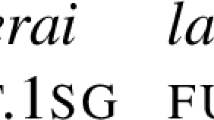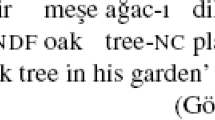Abstract
We examine the notion of ‘(inflectional) periphrasis’ within the framework of Canonical Typology, and argue that the canonical approach allows us to define a logically coherent notion of periphrasis. We propose a set of canonical criteria for inflectional morphology and a set of canonical criteria for functional syntax, that is, syntactic constructions which include functional elements and which express grammatical features. We argue that canonical periphrasis is exemplified in our theoretical space of possibilities whenever a cell in a (canonically morphological) inflectional paradigm (‘feature intersection’) is expressed by a multiword construction which respects the canonical properties of functional syntax. We compare our canonically-based approach with the approach of other authors, notably, Ackerman & Stump (2004), who argue for three sufficient conditions for a construction to be regarded as periphrastic: feature intersection, non-compositionality and distributed exponence. We argue that non-compositionality and distributed exponence, while sometimes diagnostic of periphrasis on a language-particular basis, do not constitute canonical properties of periphrasis. We also examine crucial but neglected syntactic aspects of periphrastic constructions: recursion of periphrases and headedness of periphrastic constructions. The approach we propose allows us to distinguish between constructions in actual languages which approximate the ideal of canonical periphrasis to various degrees without committing us to a categorical distinction between periphrastic and non-periphrastic constructions. At the same time we can capture the intuition that there is in some languages a distinct identifiable set of multiword constructions whose principal role is to realize grammatical features.
Similar content being viewed by others
References
Ackerman, F. (2000). Lexical constructions: Paradigms and periphrastic expressions. Paper read at the LFG workshop on Morphosyntax.
Ackerman F., Stump G., Webelhuth G. (2011) Lexicalism, periphrasis and implicative morphology. In: Borsley R., Börjars K. (eds) Non-transformational syntax: Formal and explicit models of grammar. Blackwell, Oxford
Ackerman F., Stump G.T. (2004) Paradigms and periphrastic expression: A study in realizationbased lexicalism. In: Sadler L., Spencer A. (eds) Projecting morphology. Center for the Study of Language and Information, Stanford CA, pp 111–158
Ackerman F., Webelhuth G. (1998) A theory of predicates. Center for the Study of Language and Information, Stanford, CA
Aikhenvald, A., Dixon, R.M.W., Dixon, R.M.W. (eds) (2006) Serial verb constructions: A cross-linguistic typology. Oxford University Press, Oxford
Anderson G.D.S. (2006) Auxiliary verb constructions. Oxford University Press, Oxford
Bach E. (1988) Categorial grammars as theories of language. In: Oehrle R., Bach E., Wheeler D. (eds) Categorial grammars and natural language structures. D. Reidel, Dordrecht, pp 17–34
Baerman M., Brown D., Corbett G.G. (2005) The syntax–morphology interface: A study of syncretism. Cambridge University Press, Cambridge
Bonami O., Samvelian P. (2009) Inflectional periphrasis in Persian. In: Müller S. (ed) Proceedings of the HPSG 2009 conference. CSLI, Stanford, pp 26–46
Bonami, O., & Webelhuth, G. (forthcoming). The phrase-structural diversity of periphrasis: A lexicalist account. In M. Chumakina & G. G. Corbett (Eds.), Periphrasis: The role of syntax and morphology in paradigms. Proceedings of the British Academy. Oxford: British Academy/Oxford University Press.
Booij G. (1996) Inherent versus contextual inflection and the split morphology hypothesis. In: Booij G., Marle J. (eds) Yearbook of morphology 1995. Kluwer, Dordrecht, pp 1–15
Börjars K. (1998) Feature distribution in Swedish noun phrases. Blackwell, Oxford
Börjars K., Vincent N., Chapman C. (1997) Paradigms, pronominal inflection and periphrasis. In: Booij G., Marle J. (eds) Yearbook of morphology. Kluwer, Dordrecht, pp 155–180
Bresnan J. (2001) Lexical functional syntax. Blackwell, Oxford
Bybee J.L., Perkins R.D., Pagliuca W. (1994) The evolution of grammar: Tense, aspect and modality in the languages of the world. University of Chicago Press, Chicago
Comrie B. (2003) agreement gets trigger-happy. In: Brown D., Corbett G.G., Tiberius C. (eds) Agreement: A typological perspective Special issue of Transactions of the Philological Society 101, no. 2. Blackwell, Oxford, pp 313–337
Corbett G.G. (2003) Agreement: the range of the phenomenon and the principles of the Surrey Database of Agreement. In: Brown D., Corbett G.G., Tiberius C. (eds) Agreement: A typological perspective Special issue of Transactions of the Philological Society 101 no. 2. Blackwell, Oxford, pp 155–202
Corbett G.G. (2006) Agreement. Cambridge University Press, Cambridge
Corbett G.G. (2007) Canonical typology, suppletion and possible words. Language 83: 8–42
Corbett G.G. (2008) Determining morphosyntactic feature values: The case of case. In: Corbett G.G., Noonan M. (eds) Case and grammatical relations: Studies in honor of Bernard Comrie. John Benjamins, Amsterdam, pp 1–34
Corbett, G. G. (2010a). Features: Essential notions. In A. Kibort & G. G. Corbett (Eds.), Features: Perspectives on a key notion in linguistics (pp. 17–36). Oxford: Oxford University Press.
Corbett G.G. (2010b) Canonical derivational morphology. Word Structure 3: 141–155
Corbett, G. G. (forthcoming). Periphrasis and possible lexemes. In M. Chumakina & G. G. Corbett (Eds.), Periphrasis: The role of syntax and morphology in paradigms. Proceedings of the British Academy. Oxford: British Academy/Oxford University Press.
Corbett, G.G., Fraser, N.M., McGlashan, S. (eds) (1993) Heads in grammatical theory. Cambridge University Press, Cambridge
Delsing, L. (1993). The internal structure of noun phrases in the Scandinavian languages. PhD dissertation, University of Lund.
Enfield N.J. (2007) A grammar of Lao. Mouton de Gruyter, Berlin
Evans N. (1995) A grammar of Kayardild. Mouton de Gruyter, Berlin
Evans N. (2003) Typologies of agreement: Some problems from Kayardild. In: Brown D., Corbett G.G., Tiberius C. (eds) Agreement: A typological perspective Special issue of Transactions of the Philological Society 101 no. 2. Blackwell, Oxford, pp 203–234
Everaert, M., Linden, E-J., Schenk, A., Schreuder, R. (eds) (1995) Idioms Structural and psychological perspectives. Lawrence Erlbaum Associates, Hillsdale, NJ
Hankamer J., Mikkelsen L. (2002) A morphological analysis of definite nouns in Danish. Journal of Germanic Linguistics 14: 137–175
Hankamer J., Mikkelsen L. (2005) When movement must be blocked: A reply to Embick and Noyer. Linguistic Inquiry 36: 85–125
Hankamer J., Mikkelsen L. (2008) Definiteness marking and the structure of Danish pseudopartitives. Journal of Linguistics 44: 317–346
Haspelmath, M. (2000). Periphrasis. In G. Booij, C. Lehmann, & J. Mugdan (Eds.), Morphology: A handbook on inflection and word formation (pp. 654–664). Berlin: de Gruyter.
Heck F., Müller G., Trommer J. (2008) A phase-based approach to Scandinavian definiteness marking. In: Chang C.B., Haynie H.J. (eds) Proceedings of the 26th West Coast conference on formal linguistics. Cascadilla, Somerville, MA, pp 226–233
Heine B., Kuteva T. (2002) World lexicon of grammaticalization. Cambridge University Press, Cambridge
Honda, I. (1996). Negation: A cross-linguistic study. PhD thesis, University of Buffalo.
Hudson R.A. (1987) Zwicky on heads. Journal of Linguistics 23: 109–132
Julien M. (2005) Nominal phrases from a Scandinavian perspective. John Benjamins, Amsterdam
Kahrel, P. (1996). Aspects of negation. PhD Dissertation, University of Amsterdam.
Matthews P.H. (1974) Morphology. Cambridge University Press, Cambridge
Matthews P.H. (2007) Syntactic relations: A critical survey. Cambridge University Press, Cambridge
Nerbonne J. (1996) Computational semantics—Linguistics and processing. In: Lappin S. (eds) The handbook of contemporary semantic theory. Blackwell, Oxford, pp 461–484
Nikolaeva, I. (forthcoming). Periphrasis in Nenets. In M. Chumakina & G. G. Corbett (Eds.), Periphrasis: The role of syntax and morphology in paradigms. Proceedings of the British Academy. Oxford: British Academy and Oxford University Press.
Nikolaeva, I., & Spencer, A. (2008). Nouns as adjectives and adjectives as nouns. ms.
Nunberg G., Sag I.A., Wasow T. (1994) Idioms. Language 70: 491–538
Plank, F. (1994). Inflection and derivation. In R. E. Asher & J. M. Y. Simpson (Eds.), The encyclopedia of language and linguistics (Vol. 3, pp. 1671–1678). Oxford: Pergamon Press.
Polinsky, M. (2003). Non-canonical agreement is canonical. In D. Brown, G. G. Corbett, & C. Tiberius (Eds.), Agreement: A typological perspective. Special issue of Transactions of the Philological Society 101 no. 2 (pp. 279–312). Oxford: Blackwell.
Popova G. (2010) Features in periphrastic constructions. In: Kibort A., Corbett G.G. (eds) Features: Perspectives on a key notion in linguistics. Oxford University Press, Oxford, pp 166–184
Popova, G., & Spencer, A. (forthcoming). Relatedness in periphrasis: A paradigm-based perspective. In M. Chumakina & G. G. Corbett (Eds.), Periphrasis: The role of syntax and morphology in paradigms. Proceedings of the British Academy. Oxford: British Academy/Oxford University Press.
Poser W.J. (1992) Blocking of phrasal constructions by lexical items. In: Sag I., Szabolcsi A. (eds) Lexical matters. CSLI, Stanford, CA, pp 111–130
Rosch E. (1973) Natural categories. Cognitive Psychology 4: 328–335
Rounds C. (2001) Hungarian. An essential grammar. Routledge, London
Sadler L., Spencer A. (2001) Syntax as an exponent of morphological features. In: Booij G., Marle J. (eds) Yearbook of morphology 2000. Kluwer, Dordrecht, pp 71–96
Salminen, T. (1997). Tundra Nenets inflection. Mémoires de la Société Finno-Ougrienne (Vol. 227), Helsinki.
Scatton E. (1984) A reference grammar of modern Bulgarian. Slavica Publishers, Columbus, OH
Seifart, F. (2005). The structure and use of shape-based noun classes in Miraã (North West Amazon). PhD thesis, Radboud University, Nijmegen.
Spencer A. (2001) The paradigm-based model of morphosyntax. Transactions of the Philological Society 99: 279–313
Spencer A. (2003) Periphrastic paradigms in Bulgarian. In: Junghanns U., Szucsich L. (eds) Syntactic structures and morphological information. Mouton de Gruyter, Berlin, pp 249–282
Spencer, A. (2007). Extending deponency. In M. Baerman, G. G. Corbett, D. Brown, & A. Hippisley (Eds.), Deponency and morphological mismatches (pp. 45–70). Proceedings of the British Academy, 145. Oxford: Oxford University Press.
Spencer A. (2008) Negation in Japanese: A case of morphosyntactic mismatch. Lingua 118: 997–1017
Spencer, A. (ms.). Sentence negation and periphrasis. Unpublished manuscript, University of Essex.
Stump G.T. (1998) Inflection. In: Spencer A., Zwicky A.M. (eds) Handbook of morphology. Blackwell, Oxford, pp 13–43
Stump, G. T. (2001). Inflectional morphology: A theory of paradigm structure. Cambridge studies in linguistics. Cambridge: Cambridge University Press.
Stump G.T. (2005) Word-formation and inflectional morphology. In: Štekauer P., Lieber R. (eds) Handbook of word-formation. Springer, Dordrecht, pp 49–71
Stump G.T. (2006) Heteroclisis and paradigm linkage. Language 82: 279–322
Stump, G.T., & Finkel, R. (2008). Stem alternations and principal parts in French verb inflection. Paper presented at Décembrettes 6: Colloque International de Morphologie, “Morphologie et classes flexionnelles”, December 4–5, 2008. France: Université de Bordeaux.
Suthar, B. K. (2006). Agreement in Gujarati. PhD Dissertation, University of Pennsylvania.
Thornton, A. (2008). A non-canonical phenomenon in Italian verb morphology: Double forms realizing the same cell. Paper read at the first Oxford workshop on Romance verb morphology, 27–28 August 2008, Oxford.
Thornton A. et al (2011) Overabundance (multiple forms realizing the same cell): A non-canonical phenomenon in Italian verb morphology. In: Goldbach M. (ed) Morphological autonomy: Perspectives from Romance inflectional morphology. Oxford University Press, Oxford, pp 362–385
Toivonen, I. (2003). Non-projecting words: A case study of Swedish particles. In Studies in natural language and linguistic theory 58. Dordrecht: Kluwer.
Vet, C. (2007). The descriptive inadequacy of Reichenbach’s tense system: A new proposal. In L. de Saussure, J. Moeschler, & G. Puskas (Eds.), Tense, Mood and aspect: Theoretical and descriptive issues (pp. 7–26). Amsterdam: Rodopi.
Westney P. (1995) Modals and periphrastics in English. Max Niemeyer Verlag, Tübingen
Zwicky A.M. (1985) Clitics and particles. Language 61(2): 283–305
Author information
Authors and Affiliations
Corresponding author
Rights and permissions
About this article
Cite this article
Brown, D., Chumakina, M., Corbett, G. et al. Defining ‘periphrasis’: key notions. Morphology 22, 233–275 (2012). https://doi.org/10.1007/s11525-012-9201-5
Received:
Accepted:
Published:
Issue Date:
DOI: https://doi.org/10.1007/s11525-012-9201-5




